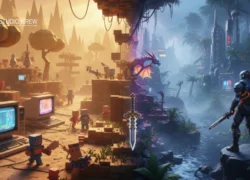In today’s dynamic digital landscape, gaming has evolved into a multi-billion-dollar industry, captivating audiences worldwide with its immersive experiences and engaging gameplay. Game Development Companies have carved Card games out a significant niche among the plethora of gaming genres, drawing players of all ages with their blend of strategy, skill, and chance. From the traditional appeal of classics like poker and solitaire to the strategic depth of modern collectable card games (CCGs), the allure of card gaming knows no bounds.
Recent market research underscores the growing prominence of card games in the gaming ecosystem. According to Newzoo, a leading provider of gaming analytics, the global mobile gaming market is projected to surpass $100 billion in revenue by 2023, with card games constituting a substantial portion of this burgeoning sector. The accessibility of mobile devices has democratized gaming, allowing players to enjoy their favourite card games anytime, anywhere, further fueling the industry’s growth.
However, the transition from physical decks to digital platforms presents unique challenges and opportunities for developers. This is where card game development services come into play, offering specialized expertise in crafting captivating digital card games tailored to the demands of today’s discerning players. A game development company specializing in card games brings together a diverse team of designers, developers, and artists to transform creative concepts into fully realized gaming experiences.
As we delve deeper into the realm of card game development services, we’ll explore the intricate process of bringing a card game from concept to completion. From conceptualization and design to coding, testing, and deployment, each stage requires careful attention to detail and a deep understanding of player preferences and market trends. Join us on this journey as we uncover the secrets behind successful card game development and discover how StudioKrew and other leading game development companies are shaping the future of digital card gaming.
Understanding Card Game Development
Definition: What Constitutes Card Game Development?
Card game development is the art and science of creating digital or physical card games that captivate players through engaging gameplay, strategic depth, and immersive aesthetics. This process involves transforming a simple idea into a fully-fledged game, encompassing everything from initial concept and design to programming and final deployment. Card games can range from digital adaptations of classic games like solitaire and poker to innovative new genres and hybrid experiences that incorporate elements of collectable card games (CCGs) and trading card games (TCGs).
Card games are popular for both real-money gaming and casual gaming purposes. Real-money gaming includes high-stakes games such as Poker (Omaha, Texas Hold ’em, Chinese Poker), Teen Patti, Rummy, and Tiger Dragon, where players wager real money for a chance to win. Casual games like Solitaire, FreeCell, and Phase10 and custom games like 17Patti and UNO are designed for entertainment without monetary stakes, appealing to a broad audience.
Process Overview: From Concept Ideation to Design, Development, and Deployment
Concept Ideation
The initial phase involves brainstorming and generating ideas for the game. Developers and designers explore various themes, mechanics, and styles to create a unique concept that stands out in the market. This stage also includes market research to understand player preferences and identify gaps the new game could fill. The goal is to outline an entertaining game that engages and retains players over time.
Game Design
In this phase, the core gameplay mechanics are defined. This includes establishing rules, designing card interactions, and creating a balanced gameplay experience. Game designers work on prototyping and iterating their ideas, ensuring the game is fun and challenging. This stage involves creating detailed game design documents that outline every aspect of gameplay, including card abilities, turn sequences, and scoring systems.
Game Documentation
Comprehensive game documentation is a foundational aspect of card game development, facilitating clarity and organization throughout the development process. This phase involves drafting essential documents such as Data Flow Diagrams, Wireframes, Test Cases, and Server Architect Diagrams. These documents serve as a roadmap, guiding developers through the intricacies of game development and providing invaluable support for bug identification and resolution. Data Flow Diagrams visualize the data flow within the game, allowing developers to identify potential bottlenecks or scaling issues in advance. Wireframes provide a visual representation of the game’s user interface, aiding in the design and layout of game elements.
Moreover, Test Cases are pivotal in ensuring fair gameplay and preventing unethical activities. By meticulously planning game test cases during the documentation phase, developers can verify the integrity of game mechanics and backend services. Test Cases outline expected behaviours and potential edge cases, serving as a framework for testing efforts. Additionally, Server Architect Diagrams depict the architecture of the game’s server infrastructure, facilitating efficient management of high user concurrency and smooth gameplay. Together, these documentation practices streamline the development process, enhance collaboration among team members, and ultimately contribute to creating a successful card game.
Artwork and Graphic Design
Visual elements are crucial in card game development. Artists create the visual assets, including card illustrations, game boards, and user interface elements. The artwork needs to be appealing and thematic, enhancing the player’s immersion in the game world. This phase involves multiple iterations, refining initial sketches into detailed, polished designs. The visual style must be consistent and align with the game’s theme to create a cohesive aesthetic experience.
Development
This technical phase involves programming the game. Developers code the game mechanics, implement the graphics, and ensure the game runs smoothly across various platforms. This stage also includes developing AI opponents, shuffling algorithms, and any network functionality for multiplayer modes. Developers use multiple programming languages and game engines to bring the design to life, focusing on performance optimization and compatibility.
Testing and Quality Assurance
Testing and quality assurance are paramount in card game development, ensuring the reliability, fairness, and security of the gaming experience. This rigorous process encompasses testing critical areas, including backend services, multiplayer game logic, credit distributions, rake mechanics in real-money games, and RNG test cases. Thorough testing of backend services evaluates their reliability, scalability, and security, while testing multiplayer game logic ensures seamless synchronization across players. Accurate credit distributions and rake mechanics testing are crucial in real-money games to maintain player trust and regulatory compliance. At the same time, RNG test cases verify the randomness of game outcomes, preventing predictability and ensuring fairness. Aligning testing efforts with predefined test cases drafted during the planning phase further bolsters these processes, proactively identifying and addressing potential issues to prevent unethical activities and cheating attempts.
In Quality assurance (QA), testers play through the game extensively, providing feedback that helps refine and polish the final product. This phase includes playtesting sessions with real users, beta testing phases, and continuous feedback loops to ensure the game meets high standards of quality and player satisfaction.
Deployment
Once the game has been thoroughly tested and refined, it is prepared for release. This includes optimizing the game for performance, ensuring compatibility across different devices, and setting up distribution channels. The game is then launched to the public, often accompanied by marketing efforts to generate interest and drive downloads or purchases. Post-launch, developers usually provide updates and patches based on player feedback to maintain and improve the gaming experience.
Fundamental Components
Game Mechanics
The heart of any card game lies in its mechanics — the rules and systems defining how it is played. Good mechanics balance skill and chance, offering players meaningful choices and strategic depth. Well-designed mechanics keep players engaged and coming back for more. For example, mechanics such as deck building, card drawing, and resource management must be finely tuned to create a satisfying and challenging experience.
Artwork:
Visual appeal is a significant factor in attracting and retaining players. High-quality artwork enhances the game’s thematic elements and makes the overall experience more enjoyable. In digital card games, animations and visual effects add a layer of polish and excitement. Consistent and visually stunning artwork can set a game apart in a crowded market, providing an immersive and aesthetically pleasing experience that draws players into the game’s world.
UI/UX Design:
User Interface (UI) and User Experience (UX) design are critical to making the game accessible and enjoyable. A well-designed UI ensures players can easily navigate menus, understand game rules, and manage their cards. Good UX design makes the gameplay intuitive and seamless, reducing friction and enhancing player satisfaction. Elements such as button placement, visual cues, and feedback systems are meticulously designed to ensure a smooth and engaging player experience.
Sound Effects:
Although often overlooked, sound effects and music play a crucial role in creating an immersive gaming experience. Background music sets the mood, while sound effects provide feedback and enhance the sense of interaction. In digital card games, sound design can significantly impact the game’s overall feel and engagement level. Sound effects for card draws, shuffles, and particular actions add a layer of realism and excitement, while background music can enhance the thematic atmosphere of the game.
RNG Algorithm:
Random Number Generation (RNG) algorithms are fundamental to card games, ensuring fairness and unpredictability in gameplay. A well-implemented RNG algorithm ensures that card draws and game events occur randomly, preventing any predictable patterns that could undermine the game’s integrity. This is crucial for maintaining player trust, particularly in competitive or multiplayer environments where fairness is paramount.
Security
Security is a critical component, especially in digital card games where transactions and personal data are involved. Implementing robust security measures protects against cheating, hacking, and fraud. Encryption, secure authentication protocols, and regular security audits help safeguard the game’s integrity and player data, ensuring a safe and trustworthy gaming environment.
Server Architecture
Efficient server architecture is essential to manage high user concurrency and ensure smooth gameplay. Scalable server solutions allow the game to handle large numbers of simultaneous players without performance degradation. This involves load balancing, real-time data synchronization, and efficient database management to provide a seamless multiplayer experience and minimize downtime.
By understanding the intricacies of card game development, from initial concept to final deployment, one can appreciate the effort and expertise required to create a successful card game. Each component, from mechanics to artwork and UI/UX design, is vital in crafting an engaging and immersive experience for players. As we continue to explore the realm of card game development services, we will delve into the latest trends shaping this dynamic industry, offering insights into how developers are pushing the boundaries of innovation and creativity.
Trends in Card Game Development
Rise of Mobile Gaming: The Proliferation of Smartphones Has Led to a Surge in Mobile Card Game Development
The explosive growth of mobile gaming has significantly impacted card game development through mobile game development services. With smartphones becoming ubiquitous, mobile card games have become increasingly popular, offering players the convenience of gaming on the go. According to a report by Newzoo, mobile gaming accounted for 49% of the global gaming market in 2022, and this trend shows no signs of slowing down. This shift has driven developers to focus on creating engaging, accessible, and visually appealing card games optimized for mobile devices.
Mobile card games like Hearthstone and Clash Royale have set new standards for the genre, combining strategic depth with intuitive touch controls. These games leverage the power of modern smartphones to deliver high-quality graphics and smooth gameplay, providing an experience comparable to console or PC gaming. The rise of mobile gaming has also led to innovative monetization strategies, such as in-app purchases and subscription models, making card games more profitable for developers while offering players enhanced content and features.
Integration of Augmented Reality (AR) and Virtual Reality (VR): How These Technologies Are Reshaping the Gaming Experience
AR and VR game development companies are transforming the card game industry with the use of various AR and VR technologies such as MLKit, TensorFlow, Baracuda, and ARKit. They are providing immersive experiences that traditional platforms cannot match. AR overlays digital elements in the real world, allowing players to interact with card games in their physical environment. For example, games like “Pokémon TCG” and “Yu-Gi-Oh!” have integrated AR features, enabling players to see holographic cards come to life on their tables, enhancing the tactical and visual experience.
On the other hand, VR creates entirely virtual environments, transporting players into the game world. VR card games provide a unique, immersive experience where players can feel like sitting at a table in a grand casino or a fantasy realm. Games like “Table of Tales: The Crooked Crown” and “Catan VR” have demonstrated the potential of VR in bringing card games to life, offering a level of engagement and immersion that traditional screens cannot achieve.
As AR and VR technologies evolve and become more accessible, we can expect more card games to incorporate these features, providing players with innovative and captivating experiences.

Cross-Platform Compatibility: The Importance of Ensuring Seamless Gameplay Across Various Devices and Operating Systems
Cross-platform compatibility has become crucial to card game development in today’s interconnected world. Players expect to enjoy their favourite games seamlessly across different devices, whether using a mobile phone, tablet, PC, or web browser. Ensuring that a card game is accessible and functional across multiple platforms broadens its audience and enhances player retention and satisfaction.
Developers are increasingly adopting technologies like Unity and Unreal Engine to build games that can easily be ported across various platforms. Cross-platform play allows friends to compete and collaborate regardless of their device, fostering a more inclusive and engaging gaming community. Popular card games like “Hearthstone” and “Gwent” have successfully implemented cross-platform functionality, allowing players to switch between devices without losing progress, enhancing the overall gaming experience.
Massive Multiplayer Online Games Played with Collectible Cards
Massive Multiplayer Online (MMO) games that utilize collectable cards are gaining traction. These games combine the social aspects of MMOs with the strategic depth of card games. These games often feature expansive worlds, player-versus-player (PvP) battles, and cooperative missions, all centred around collectable cards that players can gather, trade, and upgrade. This fusion creates a dynamic and engaging experience that keeps players invested over the long term.
Games like “Magic: The Gathering Arena” and “Legends of Runeterra” have capitalized on this trend, offering rich lore, competitive gameplay, and extensive card collections. These games often include regular updates, new card releases, and live events, keeping the content fresh and exciting. The MMO aspect allows for a vibrant community where players can connect, compete, and collaborate, enhancing the overall experience.
The integration of collectable cards in MMOs not only adds a layer of strategy and depth but also provides a continuous stream of new content and challenges for players. As this trend continues to grow, we expect to see more innovative and complex card-based MMOs entering the market.
By understanding these critical trends in card game development, from the rise of mobile gaming to the integration of AR/VR and the importance of cross-platform compatibility, it becomes evident that the industry is constantly evolving. Game Developers leverage new technologies and adapt to changing player preferences to create immersive, accessible, and engaging card games. As we delve deeper into card game development services, these trends highlight the innovative approaches shaping the future of this dynamic and exciting industry.
Top Card Game Development Companies
StudioKrew: Expertise in Developing Custom Card Games Tailored to Clients’ Needs
StudioKrew stands out in the card game development industry, offering unparalleled expertise and dedication to crafting custom card games that meet clients’ unique requirements. With a presence in the USA, UK, UAE, and headquarters in India, and a team of seasoned game developers, designers, and strategists, StudioKrew excels in transforming imaginative concepts into compelling and high-quality card games for all the leading platforms. They provide services using game engine leaders like Unity 3D, Unreal, GoDot, and React. Their portfolio showcases a variety of successful projects, ranging from traditional card games to innovative new formats, each tailored to provide an engaging player experience.

One of StudioKrew’s key strengths is its ability to integrate sophisticated game mechanics with stunning visual designs. They understand the importance of balance and strategy in card games and work diligently to ensure that every game they develop offers a fair and enjoyable experience. Additionally, StudioKrew strongly emphasizes user interface (UI) and user experience (UX) design, ensuring that their games are not only visually appealing but also intuitive and easy to navigate.
Moreover, StudioKrew is adept at incorporating the latest technological advancements into their projects. From leveraging augmented reality (AR) and virtual reality (VR) to enhance gameplay to ensuring cross-platform compatibility for seamless gaming experiences across different devices, StudioKrew stays at the forefront of industry trends. Their commitment to innovation and quality makes them a top choice for clients looking to develop standout card games.

Other Notable Developers: Mention Industry Leaders and Innovative Studios Making Waves in the Field
Zynga
Zynga is a well-known name in the gaming industry, particularly for its social games. Their expertise in creating engaging card games such as Zynga Poker and Words with Friends has cemented their reputation as a leader in the space. Zynga’s games are known for their high-quality graphics, user-friendly interfaces, and the ability to connect players worldwide, fostering a strong sense of community and competition.
Supercell
Supercell, the studio behind the massively popular Clash Royale, has made significant strides in the card game development sector. Clash Royale combines elements of collectible card games with real-time strategy and has set a new benchmark for mobile card games. Supercell’s focus on constant updates and player feedback has helped them maintain a loyal player base and continuously improve their offerings.
Blizzard Entertainment
Blizzard Entertainment has been a dominant force in the gaming world for decades, and their card game, Hearthstone, is a testament to their expertise. Hearthstone’s success can be attributed to its deep strategic gameplay, extensive card collection, and Blizzard’s commitment to balancing and expanding the game. The studio’s dedication to creating a polished and engaging experience has earned Hearthstone a massive following.
Riot Games
Known for their flagship title, League of Legends, Riot Games has expanded into the card game arena with Legends of Runeterra. This game has been praised for its innovative mechanics, rich lore, and high-quality production values. Riot Games’ approach to combining strategic depth with accessible gameplay has resonated well with players, making Legends of Runeterra a standout title in the card game genre.
CD Projekt Red
CD Projekt Red, famous for The Witcher series, ventured into card games with Gwent. Initially a mini-game within The Witcher 3, Gwent has evolved into a standalone game with a dedicated player base. Known for its unique mechanics and deep strategic elements, Gwent showcases CD Projekt Red’s ability to create engaging and complex card games.
Playtika
Playtika specializes in social and casual games and has a strong presence in the card game market. Their game, World Series of Poker (WSOP), offers an authentic poker experience with a social twist. Playtika’s focus on social features, tournaments, and player engagement has helped them carve out a niche in the card game development sector.
These industry leaders and innovative studios exemplify the diversity and creativity within the card game development field. By leveraging their expertise and staying attuned to player preferences and technological advancements, they continue to push the boundaries of what card games can offer. Whether through groundbreaking mechanics, immersive experiences, or cross-platform play, these developers are shaping the future of card games, making it an exciting time for players and creators alike.
Are you searching for top mobile game development companies? Read the post.
Factors to Consider When Choosing a Card Game Development Service
Experience and Expertise: Look for Developers with a Proven Track Record in Creating Successful Card Games
When selecting a card game development service, the developer’s experience and expertise should be your top priority. A proven track record in creating successful card games demonstrates their ability to deliver high-quality products that resonate with players. Look for game development companies that have worked on various card games, including traditional and innovative formats. Their portfolio should showcase various projects highlighting their skills in game mechanics, design, and user engagement.
Experienced game developers bring valuable insights into the development process, helping to avoid common pitfalls and ensuring a smoother journey from concept to launch. They are adept at balancing gameplay, creating compelling narratives, and incorporating engaging features that keep players returning. Moreover, their familiarity with the latest industry trends and technologies can be a significant advantage, ensuring your game stands out in a competitive market.
Legal Contract and Non-Disclosure Agreement: Protecting Your Intellectual Property
One critical aspect of partnering with a card game development company is protecting your intellectual property (IP). A comprehensive legal contract and a non-disclosure agreement (NDA) are essential to safeguard your game’s core logic, RNG algorithms, game mechanics, and reward systems. These documents help prevent the unauthorized sharing or resale of your proprietary information, which could otherwise lead to significant financial losses and damage to your competitive edge.
When drafting these agreements, ensure they cover all aspects of your project, including confidentiality obligations, IP ownership, and breach penalties. Clear terms regarding using and distributing your game’s assets can prevent misunderstandings and protect your interests. It’s advisable to consult with a legal professional experienced in intellectual property law to ensure that your contracts are robust and enforceable.
Customization Options: The Ability to Tailor the Game to Your Specific Requirements and Target Audience
Customization is another vital factor when choosing a card game development service. A game development company’s ability to tailor the game to your specific requirements and target audience can significantly impact the success of your project. Whether you have a clear vision for your game or need guidance to refine your ideas, a good development service will work closely with you to bring your vision to life.
Customization can involve various aspects, such as unique game mechanics, bespoke artwork, specialized UI/UX design, and personalized sound effects. It also includes the ability to integrate specific features that cater to your target audience, such as social sharing options, competitive leaderboards, or localized content for different regions. By tailoring the game to your audience’s preferences and needs, you enhance player engagement and satisfaction, which are crucial for long-term success.
Support and Maintenance: Ensure the Developer Offers Ongoing Support and Updates Post-Launch
The launch of your card game is just the beginning. To ensure its continued success, you need a game development company that offers comprehensive support and maintenance services post-launch. This includes regular updates to fix bugs, introduce new features, and keep the game compatible with the latest devices and operating systems. Ongoing support helps to maintain a high-quality player experience and adapt to changing market conditions.
A reliable card game development company will provide a detailed post-launch support plan outlining how it will address issues, implement updates, and respond to player feedback. It should also offer analytics tools to monitor the game’s performance and identify areas for improvement. Regular updates keep your game fresh and engaging and demonstrate your commitment to delivering a top-notch gaming experience, fostering player loyalty and retention.
Considering these factors—experience and expertise, legal protection, customization options, and support and maintenance—can significantly influence the success of your card game development project. These elements ensure that your game resonates with your target audience and provides a seamless and enjoyable experience that keeps players returning for more.
StudioKrew stands out as an exemplary choice for card game development services. With a proven track record of successful projects, a strong focus on intellectual property protection, extensive customization options, and robust post-launch support, StudioKrew is well-equipped to meet all your game development needs. As one of the leading game development companies, their comprehensive approach ensures that your vision is realized to its fullest potential, making them a top contender for anyone looking to develop a standout card game. By partnering with StudioKrew, you can be confident that your project is in capable hands and ready to achieve great success in the market. Connect with the StudioKrew Business Team.
BONUS: From Concept to Launch: StudioKrew’s Game Development Process Demystified
Case Studies
Showcasing Successful Card Game Projects Developed by StudioKrew
To truly understand the capabilities of a card game development company, it’s helpful to look at real-world examples of their work. Here, we showcase some of the successful card game projects developed by StudioKrew, a leading game development company, highlighting unique features, challenges faced, and the impact these games have had on the market.
1. 17Patti Pro: Custom Card Real Money Game
17Patti Pro is a custom card game designed for real-money gameplay. This game introduces unique gameplay mechanics and sophisticated algorithms that enhance the user experience.
Unique Features:
- Custom Card Distribution Algorithms: These algorithms ensure fair and random distribution of cards, which is crucial for maintaining trust in a real-money gaming environment.
- Hand Comparison Algorithms: Accurate hand comparison ensures transparency and fairness, which are essential for competitive gameplay.
- Prize Distribution Algorithms: Real-time prize distribution maintains the game’s integrity and immediately rewards winners.
Challenges Faced:
- Ensuring Fairness and Transparency: Developing algorithms that are both fair and transparent to players.
- Maintaining Real-Time Performance: Ensuring the game performs well under various conditions, including high user concurrency.
Market Impact: 17Patti Pro has gained popularity among players seeking a reliable and engaging real-money card game. Its advanced algorithms and fair play have set a new standard in the industry.
2. 10 Phase
10 Phase is another notable card game developed by StudioKrew for a client with their existing demanding multi-gaming Application published in MENA, India, and the USA region. It is designed to provide a dynamic and engaging gameplay experience. With its simple rules and strategic gameplay, Phase 10 has captivated players worldwide.
Unique Features:
- Strategic Gameplay: To advance, players must complete specific phases of cards, adding depth and strategy to the game.
- Variety of Phases: Offers a variety of challenging phases to keep players engaged and entertained.
- Multiplayer Options: Supports multiplayer gameplay, allowing friends and family to compete against each other.
- Interactive Design: Features an interactive design that enhances user engagement and satisfaction.
Challenges Faced:
- Balancing Gameplay: Ensuring the game is challenging yet enjoyable for players of all skill levels.
- User Retention: Implementing features that keep players coming back for more.
Market Impact: 10Phase has been well-received for its engaging gameplay and innovative mechanics, contributing to its success in the market.
3. NFT-Based Motion Game with Collectibles
This game leverages blockchain technology to offer NFT-based collectibles that players can earn by achieving milestones.
Unique Features:
- NFT Integration: Allows players to earn unique, tradable collectibles.
- Motion-Based Gameplay: Utilizes motion-sensing technology to create an immersive experience.
Challenges Faced:
- Blockchain Integration: Ensuring smooth integration of blockchain technology with the game’s existing systems.
- Security: Protecting players’ NFT assets from potential security threats.
Market Impact: This game has attracted a tech-savvy audience interested in blockchain and NFTs, setting a new trend in the gaming industry.
4. Metaverse Game
This ambitious project targets massive online users. Players mine resources to earn unique cards generated by backend logic.
Unique Features:
- Spatial Audio: Enhances the immersive experience by providing real-time audio based on players’ locations.
- Real-Time Physics Sync: Ensures all players experience the same physical interactions in real time.
- Mini Interactive Games: Offers additional gameplay elements to keep players engaged.
Challenges Faced:
- Scalability: Developing a server architecture capable of handling a large number of concurrent users.
- Ensuring Uniqueness: Implementing backend logic that guarantees each generated card is unique.
Market Impact: The Metaverse Game has made significant global waves, showcasing the potential of integrating advanced technologies to create unique and engaging gaming experiences.
These case studies highlight StudioKrew’s diverse capabilities in developing cutting-edge card games. Their expertise in creating custom algorithms, integrating new technologies, and addressing complex challenges positions them as a top choice for anyone looking to develop a standout card game. Whether you’re interested in real-money gaming, NFT integration, or large-scale online experiences, StudioKrew can deliver exceptional results.

Conclusion
In this article, we delved into the intricate world of card game development, covering essential topics such as understanding the development process, recognizing current trends, and identifying crucial factors for selecting a development service. We explored the comprehensive steps involved in card game development, from concept ideation and detailed game documentation to rigorous testing and quality assurance. Additionally, we highlighted the importance of keeping up with emerging trends like mobile gaming, AR/VR integration, cross-platform compatibility, and the rise of Massive Multiplayer online card games.
Partnering with a reputable card game development company is vital to transforming your vision into a successful game. A seasoned Mobile Game Development Company like StudioKrew can provide invaluable expertise and support throughout the development process. With their experience in custom game development, StudioKrew ensures that your game not only meets technical standards but also engages and delights players. Their commitment to excellence in game mechanics, UI/UX design, and security measures make them a top choice for anyone looking to develop a standout card game.
We encourage you to explore the diverse world of card games, whether as a player or a potential developer. The card game industry offers rich experiences and opportunities, from casual mobile games to complex real-money gaming platforms. By understanding the development process and choosing the right partners, you can contribute to this dynamic field and create games that captivate audiences worldwide.
In conclusion, the journey of card game development is filled with exciting possibilities. By leveraging the expertise of a leading Card Game Development Company like StudioKrew, you can bring your creative visions to life and make a significant impact in the gaming world. Whether you’re looking to develop a new card game or enjoy the vast array of existing ones, the future of card gaming is bright and full of potential.





